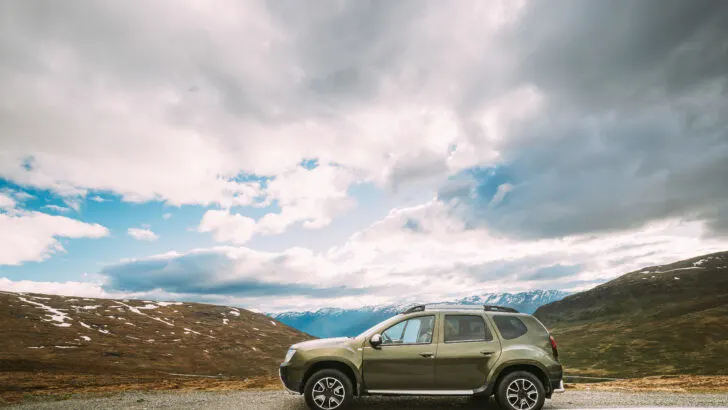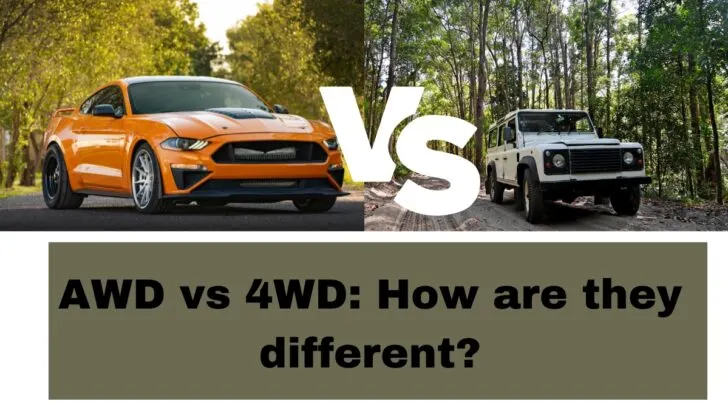Whether you have just purchased a new vehicle or might be planning to purchase one in the near future, you may have noticed different vehicles advertise being AWD or 4WD. These are two of the most common drivetrains vehicles will have, and they both have their pros and cons.
All-wheel drive (AWD) is an automatic system, meaning you are not able to select whether or not you need more power to the front or the rear wheels, and will instead have to rely on the vehicle’s sensors to make that determination. 4WD, on the other hand, allows the driver to make manual changes when more power is added.
This article takes a closer look at the differences and which one might be better for your needs when it comes to purchasing a new vehicle.
What Is AWD?
AWD, or all-wheel drive, is one of the more common power systems vehicles have. This system powers both the front and rear wheels on small cars, vans, SUVs, trucks, and other styles of vehicles without you having to select a specific drivetrain method.
All-wheel drive comes in two different versions which can be found across a wide range of different vehicles. These versions include full-time and part-time AWD systems.
The more common of these two versions is the full-time all-wheel drive, while the part time all-wheel drive is found on more modern vehicles with traction systems that can adjust where the power goes when it is needed.
With all-wheel drive systems, including both full-time and part-time versions, you as the driver will not be able to select which wheels get power at any given time.
This is all done automatically by the vehicle’s computer system and will be adjusted depending on which wheels need more optimized traction or which seem to be falling behind on proper torque levels.

When driving in areas where traction is a problem, such as on ice, in snow, or in mud, full-time AWD can help ensure good handling and solid traction gain by sending a full amount of power to each of the four wheels.
With part-time AWD, power to the wheels is adjusted two at a time, either engaging the front pair of wheels or the rear pair of wheels as more traction is needed.
These modern sets control which pair of wheels is engaged with the use of automatic sensors and torque registers.
Disadvantages of AWD
While all-wheel drive is great for standard highway driving, it is normally seen as an unsuitable choice for offroading. It can handle some minor off-roading situations, such as long gravel driveways or certain maintained off-roading paths.
However, it falls very short in being useful for Jeeps, trucks, and other vehicles for serious off-roading, unexplored pathing, and rock crawling.
Another potential downside, though somewhat minor, is that an AWD system increases the overall purchase cost of the vehicle. You also may find a lower quality fuel economy, adding to higher fuel costs and more regular fill ups at the pump.
What Is 4WD?
Most commonly found on larger SUVs and pickup trucks, four-wheel drive is much more suitable for any vehicle that will be going off-road into the desert, on rough trails, when rock crawling, or even when towing trailers across rough and unmaintained roads.
4WD uses a series of differentials for the front, rear, and center of the vehicle. Working together with couplings and transfer boxes, a 4WD vehicle can provide a full amount of torque to each of the four wheels when needed.

In most cases, 4WD is switched on or off by the driver. This can be via a knob on the dash, a separate adjustment on the gear shift, or with a floor pedal.
However it is set up, being able to select whether you want the front pair of wheels or the rear pair of wheels to receive more power can help when getting up steep hills, across ditches, or when hauling heavy trailers across rough terrain.
For drivers that love venturing well off the beaten path, a part-time 4WD system is the traditional and most preferred power method.
With this setup, the vehicle is normally driven by the rear wheels, but when needed, the driver can easily turn on the four-wheel drive option adding a full amount of power to the front wheels as well.
Disadvantages of 4WD
While four-wheel drive vehicles are an excellent choice for drivers that intend to do a lot of off-roading or need the highest level of pulling power, they can also deliver a less enjoyable ride.
In many cases, a four-wheel drive vehicle’s suspension feels much stiffer and heavier-duty when compared to all-wheel drive vehicles.
However, with advances in vehicle technology, many 4WD vehicles do offer a more refined and smooth ride. They still rarely compare to a fully all-wheel drive vehicle.
Another downside is the added fuel costs when using the four-wheel drive capabilities, though this can also be due to the more difficult terrain you are traversing as well as any heavy loads you may be hauling at the same time.
Is AWD the Same As 4WD?
While both all-wheel drive and four-wheel drive vehicles have a similar drivetrain system, an AWD vehicle is not the same as a 4WD vehicle.
Unfortunately, many individuals will use these terms interchangeably which adds to overall confusion when separating the two.
All-wheel drive is an automatic system, whereas with a four-wheel drive vehicle, the driver can make manual changes when more power is added. A four-wheel drive vehicle can either be front wheel drive or rear wheel drive normally, and when manually enabled the 4WD option will add power and torque to the wheels not normally used for added traction and control.
What Is the Difference Between AWD, 4WD, and 4×4?
In almost every case, a 4WD and 4×4 vehicle will have identical drivetrain systems. The biggest difference here is that a 4×4 vehicle has power to all four wheels turned on at all times, while a 4WD vehicle can be manually switched from two to four wheel drive when the extra power and traction is needed.
All-wheel drive and 4×4 are also similar, but an AWD vehicle will make use of more sensors in order to adjust torque between the four wheels independently.
This is handled entirely by the vehicle’s computer system and the driver will not be able to adjust the power allotment.
Some very common vehicles that use a 4WD or 4×4 system are the Dodge Ram 1500 truck, the Jeep Grand Cherokee SUV, and the Nissan Titan pickup truck.
Is AWD Safer Than 4WD?
Both all-wheel drive and four-wheel drive vehicles can provide excellent traction when accelerating but can lack a bit when it comes to stopping power or cornering accuracy.
For drivers that want to ensure solid traction and control when offroading, a four-wheel drive vehicle is your best and safest option. For drivers that keep their vehicle on the paved road, but want safety and traction in rainy or icy conditions, all-wheel drive is the best choice.
Is AWD or 4WD Better For Snow?
If you know you will be driving on ice and snow during the winter or on your next road trip, you want to ensure traction in these slippery conditions is solid.
While both all-wheel drive and four-wheel drive can provide excellent traction in these conditions, one can be better suited than the other in some cases.
All-wheel drive vehicles take the guesswork out of it for the driver and leave you to focus on other things such as keeping an eye on your speed, monitoring other drivers around you, and more.
All-wheel drive systems will automatically adjust the torque that is delivered to each wheel depending on the traction that wheel is missing thanks to various sensors installed on the vehicle.
Four-wheel drive vehicles can do very well in deep snow or when hauling a trailer uphill in icy and wet conditions. However, in this case the driver will need to know when to enable or disable four-wheel drive capabilities to get the best traction from the vehicle when needed.
When searching for a new vehicle, consider your normal driving habits as well as the potential but likely winter weather you may encounter. If you plan on going offroad or will be regularly driving on roads that have not been plowed during the winter, a four-wheel drive vehicle is your best option.
If you plan on sticking to the city and know your roads will be thoroughly maintained and kept free from ice and snow throughout the season, an all-wheel drive vehicle might be your better option.
While it won’t be able to handle large snowdrifts and probably won’t be the best option for driving on unmaintained snowy roads, it can provide plenty of traction in normal situations.
Is AWD or 4WD More Powerful?
In general, both all-wheel drive and four-wheel drive vehicles are relatively equal when it comes to overall power. If you will be hauling large trailers for vehicles, livestock, or general goods, a four-wheel drive vehicle can provide the uphill oomph you need to get your heavy load from point A to point B.
If you won’t be hauling overly large trailers, or won’t be hauling any trailers at all, an all-wheel vehicle can provide all the power you need for normal daily commuting, vacation traveling, or other local and long-distance driving.
Conclusion to AWD vs. 4WD
Overall, both types of vehicles offer different benefits for driving in varying conditions.
The main difference between AWD and 4WD is that AWD is automatic whereas 4WD is manual, where the driver can choose when power is added and to which wheels.
If you found this article helpful, you may want to take a look at some of the related resources below as well!
